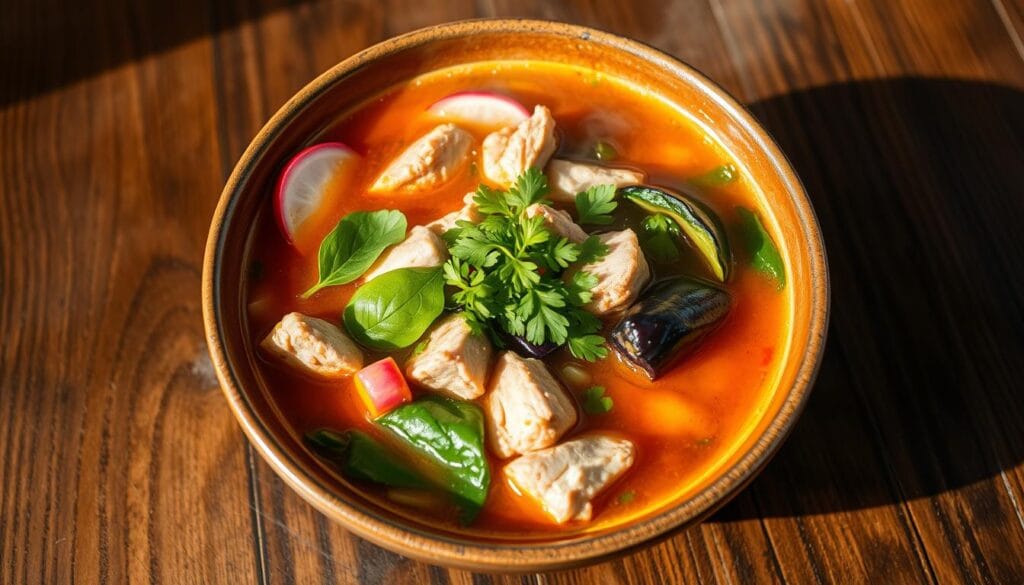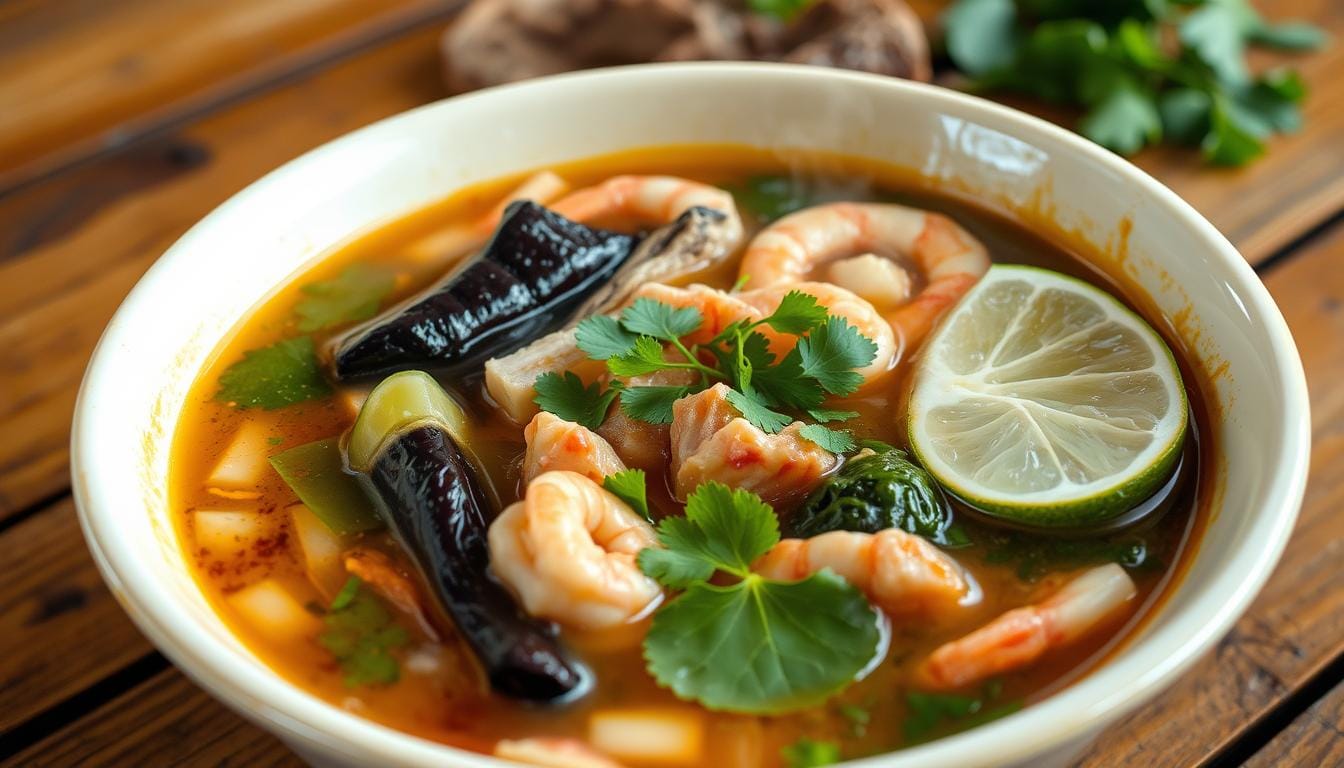As I dipped my spoon into the steaming bowl of sinigang, the tangy aroma took me back to my childhood in the Philippines. The savory broth, filled with tamarind flavors, wrapped my senses in comfort. Sinigang is more than a soup; it’s a tradition that brings joy and comfort to many.
If you love sinigang or want to try it, you’re in for a treat. We’ll explore its rich history, unique flavors, and delicious varieties. Sinigang showcases the creativity of Filipino chefs and home cooks.
So, grab your spoon, and let’s start our flavorful journey through sinigang. This tangy Filipino soup is sure to win your heart and taste buds.
Table of Contents
What is Sinigang?
Sinigang is a favorite Filipino soup loved for centuries. It comes from the Tagalog region and means “to stew” in Tagalog. It’s not just food; it’s a symbol of Filipino pride and culture.
Exploring the Origins of Sinigang
Sinigang has a rich history in the Philippines. It started with Southeast Asian stewing methods and local flavors. Now, it’s a dish that brings families and communities together.
The Cultural Significance of Sinigang in Filipino Cuisine
Sinigang is a national dish of the Philippines. It shows the country’s diverse culinary traditions. With different flavors and ingredients, it connects Filipinos everywhere.
“Sinigang is more than just a soup; it’s a celebration of Filipino culture and identity.”
Sinigang is loved for its tangy flavors and diverse ingredients. It’s a key part of Filipino cuisine. It’s enjoyed by many around the world.
The Unique Flavors of Sinigang
At the heart of sinigang’s taste is tamarind, the main souring agent. This tropical fruit adds a tangy and tart flavor. It perfectly complements the savory tastes of meat, seafood, or vegetables. This mix of flavors makes sinigang so unique and loved by Filipinos.
Tamarind: The Key Souring Agent
Tamarind is the traditional souring ingredient in sinigang. It brings a balanced acidity that is the dish’s signature. You can use fresh tamarind pulp or tamarind sinigang mixes to achieve the perfect sourness.
The Perfect Balance of Savory and Tart
While tamarind is common, sinigang can also use guava, kalamansi, or green mangoes for a tangy touch. The mix of sour elements and savory flavors creates a complex taste. This taste is unique to sinigang flavors.
“Sinigang best embodies the Filipino taste – a perfect balance of sour, salty, and sweet.”
– Doreen Fernandez, Filipino Food Anthropologist
Sinigang is enjoyed by all, regardless of taste, class, or budget. It can be made with pork, seafood, or vegetables. The core of sinigang is a mix of tamarind sinigang and other flavors, showcasing Filipino culinary tradition.
Sinigang Ingredients and Varieties
Sinigang, a favorite Filipino soup, is known for its unique flavors. The broth is made with many important ingredients. Tamarind, the main souring agent, gives the broth its tangy taste.
Other fresh vegetables like okra, daikon radish, tomatoes, and leafy greens are added. They balance the savory and tart flavors.
Essential Ingredients for a Flavorful Broth
To make a true sinigang broth, you need a few key ingredients:
- Tamarind, the main souring agent that gives sinigang its tangy flavor
- Meat or seafood, like pork, beef, chicken, shrimp, or fish, which add their own flavors
- Fresh vegetables, including okra, daikon radish, tomatoes, onions, and leafy greens like spinach or water spinach
- Seasonings like fish sauce or salt to boost the taste
Popular Sinigang Varieties: Pork, Seafood, and More
While pork sinigang is a classic, there are many other tasty versions. Shrimp sinigang and fish sinigang, with fresh seafood, are also favorites. For a meatless option, vegetable sinigang lets the produce’s natural flavors shine.
Sinigang is a comforting dish that celebrates Filipino flavors. Whether you like pork, seafood, or a vegetarian version, the secret to a great sinigang is the right mix of ingredients.

Cooking Sinigang: Step-by-Step Instructions
Making a delicious sinigang dish at home is easy and fun. Start by boiling tamarind in water to get its tangy flavor. Then, add your choice of protein like pork or seafood.
While the meat cooks, add daikon radish and eggplant first. Then, add green beans, okra, and finally, water spinach. This order lets each ingredient add its flavor to the broth. Let it simmer for about an hour and a half to get the perfect sinigang taste.
Season the broth with fish sauce and pepper as it cooks. This makes the soup full of flavor, just like Filipino cuisine. Whether you’re experienced or new to sinigang, these sinigang cooking instructions will guide you to a tasty dish everyone will love.
- Boil the souring agent (typically tamarind) in water to extract its tangy flavor.
- Add the meat or seafood and simmer until tender.
- Introduce the vegetables in a specific order, starting with the heartier ones.
- Season the broth with fish sauce and pepper to balance the flavors.
- Simmer the entire dish for about an hour and a half, allowing the ingredients to fully infuse.
Follow these sinigang cooking instructions to make a tasty and authentic Filipino sinigang dish in your kitchen.
Sinigang: A Comforting and Nutritious Meal
Sinigang, the beloved Filipino soup, is not just tasty but also very healthy. It combines tender meat or seafood, fresh veggies, and a tangy broth. This mix makes for a meal that’s both nourishing and satisfying.
The Health Benefits of Sinigang
The veggies in sinigang, like spinach, okra, and tomatoes, are packed with vitamins and minerals. They also have antioxidants. The protein from the meat or seafood adds amino acids to the meal. The sour and savory flavors make it a dish you can enjoy all year.
A serving of Oxtail Sinigang has about 350 calories, 20g of fat, and 7g of saturated fat. It also has 30g of protein. The dish has 900mg of sodium, 12g of carbs, and 4g of fiber. It’s a balanced meal.
The tamarind broth in sinigang is full of antioxidants. These can help lower body inflammation. The dish also has potassium, magnesium, and vitamin C from its natural ingredients.
Sinigang is a comforting and nutritious meal. It promotes digestive health, boosts immunity, and supports overall vitality. Its balanced and wholesome composition makes it great for your body.
“Sinigang is a nourishing dish that not only satisfies the palate but also nourishes the body with its wealth of essential nutrients.”
Regional Variations of Sinigang
Sinigang is a favorite dish in the Philippines, but it has many regional twists. These regional sinigang and sinigang variants vary in protein, souring agent, and vegetables.
In some areas, beef or seafood is used instead of pork. Local fruits like guava or bilimbi might be used for sourness. The choice of ingredients depends on the local climate and what’s available.
These regional differences highlight the creativity of Filipino cooking. From Luzon’s tangy Pork Sinigang to the Visayas’ seafood-rich Sinigang na Isda, each version is a celebration of the country’s diverse flavors.
Exploring sinigang, you might find the north’s tart Sinigang na Baboy or the south’s fragrant Sinigang na Hipon. These dishes show the skill and creativity of Filipino cooks. They not only please the taste buds but also highlight the Philippines’ rich culinary heritage.
Pork Sinigang: A Classic Filipino Favorite
Pork sinigang, or sinigang na baboy, is a favorite in the Philippines. It’s a sour soup made with tender pork and a tangy tamarind broth. This mix gives the meat rich, complex flavors.
The broth of pork sinigang is what makes it special. It’s a perfect mix of savory and tart. The tamarind, pork umami, and fresh veggies work together for a satisfying meal. Daikon radish, okra, string beans, and water spinach add texture and a bit of bitterness.
“Pork sinigang is a staple in Filipino households and a go-to choice for many when craving a taste of authentic Filipino cuisine.”
The history of sinigang na baboy goes back to before the Philippines was colonized. Influences from Malaysia, Indonesia, and Thailand shaped this dish. Now, it’s seen as one of the Philippines’ unofficial national dishes.
Pork sinigang is more than just a meal. It’s a comfort for families and a way to connect with Filipino heritage. It’s a classic that wins hearts and tastes around the world.
Tips for Making Authentic Sinigang at Home
Making the perfect homemade sinigang is more than just using instant mix sinigang. It’s about using fresh ingredients sinigang to get the real flavors of this Filipino soup.
Using Fresh Ingredients vs. Instant Mixes
Instant mix sinigang is quick but lacks the rich taste of fresh ingredients. For a true authentic sinigang recipe, follow these tips:
- Use fresh tamarind for a deeper, more balanced sourness in the broth.
- Choose seasonal, locally-sourced produce for the best flavor and freshness in your veggies.
- Pick high-quality proteins like pork, beef, or seafood for a richer taste.
Preparing homemade sinigang from scratch is worth the extra effort. The flavor and complexity are unmatched by pre-made mixes.
“Sinigang is a dish that truly shines when made with the freshest, most flavorful ingredients. The time and care you put into crafting it from scratch will be evident in every spoonful.”
So, when you want the tangy, savory taste of sinigang, try making it yourself. Your taste buds will love it!
Sinigang: A Beloved Filipino Dish
The sinigang Filipino dish is a national favorite, loved by Filipinos and food lovers everywhere. It’s a mix of tangy, savory, and comforting flavors. This dish is a staple in Filipino homes, showing the country’s rich and varied food traditions.
Sinigang brings families and communities together. It’s enjoyed on regular days and special occasions. This dish is a cherished part of Filipino cuisine, creating memories and connections at the table.
The dish’s cultural heritage is a big reason for its popularity. Over time, sinigang has changed, with different versions in different places. From pork sinigang to seafood versions, each one offers a unique taste experience.
“Sinigang is not just a dish; it’s a culinary expression of the Filipino spirit – a harmony of flavors that nourishes the body and warms the soul.”
As sinigang Filipino dish continues to win hearts, its popularity shows the richness of Filipino cuisine. Whether eaten at home or in restaurants, sinigang is a beloved part of Filipino food culture. It truly reflects the country’s vibrant and diverse food traditions.

Conclusion
Sinigang, the tangy and savory Filipino soup, has won hearts worldwide. Its unique flavor, thanks to tamarind, makes it stand out. It’s also versatile, with many proteins and vegetables to choose from.
This dish is more than just food; it brings families and communities together. Exploring sinigang’s origins and flavors has deepened our appreciation for it. It’s perfect for any meal, thanks to its quick prep and health benefits.
Our journey through sinigang ends with a deeper love for this Filipino dish. Whether you’re a long-time fan or new to it, sinigang’s flavors and traditions are unforgettable. Next time you try it, enjoy the experience and let it take you to the heart of Filipino cuisine.
FAQ
What is sinigang?
Where does sinigang originate from?
What gives sinigang its unique flavor?
What are the key ingredients in sinigang?
How is sinigang prepared?
What are the health benefits of sinigang?
Are there regional variations of sinigang?
What is the most popular variety of sinigang?
How can I make authentic sinigang at home?

Sinigang na Baboy (Pork Sinigang)
Ingredients
- For the Broth:
- 2 cups fresh tamarind pods or 1 cup tamarind paste
- 2 lbs pork preferably belly or ribs, cut into chunks
- 8 cups water
- 1 large onion quartered
- 2 tomatoes quartered
- 2 tablespoons fish sauce patis
- 1-2 green chili peppers optional
- For the Vegetables:
- 1 cup daikon radish sliced
- 1 cup eggplant sliced
- 1 cup okra ends trimmed
- 1 cup green beans trimmed
- 2 cups water spinach kangkong or regular spinach
Instructions
- Prepare the Tamarind:
- If using fresh tamarind, boil the tamarind pods in 2 cups of water for about 15 minutes until soft. Mash the tamarind in the water to extract the juice. Strain and set aside the liquid, discarding the seeds and shells. If using tamarind paste, mix it with 2 cups of water to dissolve.
- Cook the Pork:
- In a large pot, combine the pork and 8 cups of water. Bring to a boil, then reduce to a simmer. Skim off any foam that rises to the surface.
- Add Aromatics:
- Add the quartered onion and tomatoes to the pot. Stir in the fish sauce and green chili peppers. Let it simmer for about 45 minutes, or until the pork is tender.
- Add Vegetables:
- Once the pork is tender, add the daikon radish and eggplant first. Cook for about 10 minutes. Then add the okra and green beans, and cook for an additional 5-7 minutes until all the vegetables are tender.
- Add Tamarind:
- Pour in the prepared tamarind juice (or dissolved tamarind paste) into the pot. Adjust the sourness to taste. If you want it more sour, you can add more tamarind.
- Final Touch:
- Stir in the water spinach and cook for another 2-3 minutes until wilted. Taste and adjust seasoning with additional fish sauce or salt as needed.
- Serve:
- Ladle the hot sinigang into bowls and serve with steamed rice and extra chili on the side.
Notes
- Variations: You can substitute pork with beef, shrimp, or fish depending on your preference.
- Souring Agents: If tamarind is unavailable, you can also use guava or kalamansi for a different twist on the flavor.
- Storage: Leftover sinigang can be stored in the refrigerator for up to 3 days. Reheat before serving.
